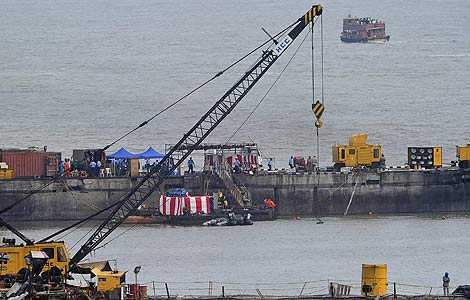
|
 |
|
Navy divers and rescue workers stand on the INS Sindhurakshak submarine during a rescue operation at a naval dockyard in Mumbai August 16, 2013. [Photo/Agencies] |
The explosion in a weapons store in the forward section of the Russian-built INS Sindhurakshak on Tuesday night caused a fire so hot it melted steel as the vessel lay berthed in Mumbai, resulting in the navy's worst loss in more than four decades.
"The bodies are severely disfigured and not identifiable due to severe burns. The bodies have been sent to INHS Ashiwini, the naval hospital for DNA identification," spokesman Narendra Vispute told reporters.
In an earlier statement, the navy said the heat of the exploding weapons made it unlikely anybody inside could have survived.
The sinking of the diesel-powered submarine is the biggest blow for the navy, both in terms of lives and the loss of a vessel, since a frigate was sunk in the 1971 war with Pakistan.
The Sindhurakshak is a Kilo class vessel, which were built in former Soviet and later Russian shipyards for the Indian navy from 1985 to 2000. The navy has 10 of the submarines and four German HDW boats.
A defence source said the navy did not have a deep submergence rescue vehicle that other navies use to save trapped sailors, although in this case the incident occurred while it was docked and not in the deep seas.
The navy said divers could not enter the Sindhurakshak for more than 12 hours because of boiling water inside parts of the vessel. Access was "almost impossible due to jammed doors and hatches, distorted ladders, oily and muddy waters".
Only one diver could work at a time initially to clear a path inside the submarine. Divers are trying to reach further inside to find the remaining bodies, the navy said.
A naval board of inquiry has been ordered into how weapons went off while the vessel was berthed in the high-security Mumbai base.
Weapons on board such a submarine include torpedoes and missiles that are launched over long ranges above water.
